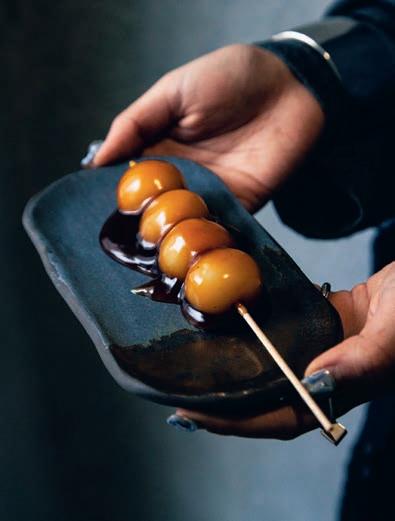
1 minute read
Review
a curtain that looks like its for employees only, it surprises with its matcha-colored walls and Japanese adornments. More traditional, it vibes like a ceremonial tea room.
LEARN YOUR (MATCHA) LESSONS
Matcha (i.e. powdered, ground green tea leaves) is not made from just ordinary green tea leaves. Leaves for matcha are grown in the shade, thereby increasing the chlorophyll content resulting in a darker green color and a more grassy taste. There are two kinds of matcha available in Japan and they are most distinguishable by their price. The more expensive is the purer, and that’s the one usually reserved for ceremonial tea drinking moments.
Less expensive is the version used in drinks or in confectionary but with most export matcha being organic, that naturally translates into the final price. So, a hat tip is due to Shota. Sourcing traditional non-organic matcha from
Translated literally to mean ‘beans and leaves’, these are primary ingredients on a menu that is short and sweet.
Japan (the Japanese choice due to its less bitter taste), find him serving match latte with a choice of four kinds of milk (including low-sugar pea milk), and two authentic Japanese superfoods: a drizzling of melted black sugar from Okinawa called kuromitsu, and sprinkled shavings of roasted soybean (kinoko) that give the mouth a subtle peanut flavor.
With chemical compounds that relieve the nerves and stress levels but never sap the strength, this is matcha the way it’s meant to be. Of course, if that sounds too much, then a ceremonial matcha is available for the same price.
For Food
The menu is kept sweet to pair well with the matcha. Of the highlights, there’s a variety of daifuku mochi which are filled with seasonal delicacies and customer’s favorite fillings. There’s also dorayaki which are two small pancake-like patties stuffed with a filling of sweet azuki bean paste. And lastly, and most instagrammable of all, dango: rice balls made from rice flour before being topped with your choice of roasted salt or a traditional sweet soy-based sauce called mitarashi.

Good To Know
Keep an eye out on their FB and, in particular, their celebrations of Japanese holidays. Open only from Wednesday through till Sunday (from 2 p.m. to 7 p.m.), sold-out desserts and waiting around are the norm if you get there late. ~ KD










